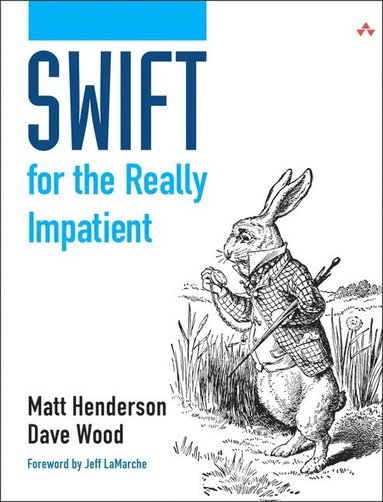
- Format
- Häftad (Paperback)
- Språk
- Engelska
- Antal sidor
- 176
- Utgivningsdatum
- 2014-12-14
- Upplaga
- 1
- Förlag
- Addison Wesley
- Medarbetare
- Wood, Dave
- Dimensioner
- 232 x 180 x 10 mm
- Vikt
- Antal komponenter
- 1
- ISBN
- 9780133960129
- 280 g
Swift for the Really Impatient
Foreword by Jeff LaMarche
- Skickas från oss inom 2-3 vardagar.
- Fri frakt över 249 kr för privatkunder i Sverige.
Passar bra ihop
De som köpt den här boken har ofta också köpt Nexus av Yuval Noah Harari (häftad).
Köp båda 2 för 477 krKundrecensioner
Fler böcker av Matt Henderson
-
Machine Learning for Beginners 2019
Matt Henderson
Want to predict what your customers want to buy without them having to tell you? Want to accurately forecast sales trends for your marketing team better than any employee could ever do? Then keep reading. You’ve heard it before. The rise of ...
-
Data Science for Business 2019 (2 BOOKS IN 1)
Riley Adams, Matt Henderson
This book includes 2 Manuscripts: Data Analytics for Businesses 2019 + Machine Learning for Beginners 2019. Are you looking for new ways to grow your business, with resources you already have? Do you want to know how the big players like Netflix, ...
Övrig information
Matt Henderson has been developing for Apple's platforms since 2009 and is currently a Cocoa Engineer at MartianCraft. He's given several presentations at various user groups and conferences, including 360iDev, Cocoaheads Denver, and Boulder iOS Meetup. His previous experience includes leading teams on both iOS and Android projects and developing in languages ranging from Java to embedded C/C++. Dave Wood has been developing for iOS since 2008 and OS X since 2009. His experience includes developing systems that interface with stock exchanges, news outlets, and banking systems; creating newspaper sites; and building mobile apps of all kinds, from games and social networks to apps for finance, productivity, and professional development. He runs his own development studio, Cerebral Gardens, and freelances as a Cocoa Engineer for MartianCraft.
Innehållsförteckning
Foreword xi
Preface xiii
Acknowledgments xv
About the Authors xvi
Chapter 1: Introducing Swift 1
1.1 Basic Syntax 2
1.1.1 Variables and Constants 2
1.1.2 String Interpolation 5
1.1.3 Control Flow 6
1.2 Basic Data Types 10
1.2.1 Int 10
1.2.2 Double and Float 12
1.2.3 Bool 13
1.2.4 Strings 14
1.2.5 Arrays 15
1.2.6 Dictionaries 19
Exercises 20
Chapter 2: Diving Deeper into Swifts Syntax 21
2.1 Optionals 22
2.2 Generics 25
2.3 Type Annotations and Type Inference 28
2.4 Functions and Closures 29
2.4.1 Global Functions 30
2.4.2 Nested Functions 30
2.4.3 Closure Expressions 31
2.5 Tuples 32
2.6 switch Statements and Pattern Matching 34
Exercises 37
Chapter 3: Objects and Classes 39
3.1 Enumerations 41
3.2 Classes 45
3.3 Structures 49
3.4 Subclassing 51
3.5 Overloading 52
3.6 Overriding 54
3.7 Initialization 55
3.8 Properties 57
3.8.1 Computed Properties 59
3.8.2 Property Observers 60
3.8.3 lazy Properties 62
3.9 Subscripting 63
3.10 Protocols 65
3.11 Extensions 67
3.12 Access Control 68
Exercises 73
Chapter 4: Optionals 75
4.1 Optionals and nil 76
4.2 Validity Checking, Optional Binding, and Forced Unwrapping 78
4.3 Optional Chaining 81
4.4 Implicitly Unwrapped Optionals 86
Exercises 88
Chapter 5: Generics 91
5.1 Why Generics? 92
5.2 Generic Functions 92
5.2.1 Type Parameters 93
5.2.2 Using More Than One Type Parameter 94
5.3 Generic Types 94
5.3.1 Associated Types 98
5.3.2 The where Clause 100
Exercises 101
Chapter 6: Functions and Closures 103
6.1 Functions 104
6.1.1 Parameters 104
6.1.2 External Parameter Names 105
6.1.3 Default Parameter Values 107
6.1.4 Variadic and inout Parameters 108
6.1.5 Return Types 110
6.2 Closures 112
6.2.1 Inferring Parameters and the Return Value 113
6.2.2 Trailing Closures 113
6.3 Functional Programming Patterns 114
Exercises 117
Chapter 7: Working with Objective-C 119
7.1 Interacting with C and Objective-C APIs 120
7.1.1 Optional Properties and Return Values 122
7.1.2 AnyObject Types 123
7.1.3 Subclassing, Extensions, and Protocols 124
7.1.4 Automatically Converted Types 126
7.1.5 Selectors and Enums 128
7....
Du kanske gillar
-
The Coming Wave (Export Edition)
Paperback / Softback -
All About Love
Bell Hooks
Häftad -
Chemistry
Andrew Burrows
Häftad -
Behave
Robert M Sapolsky
Häftad -
Calculus
Robert A Adams
Inbunden


